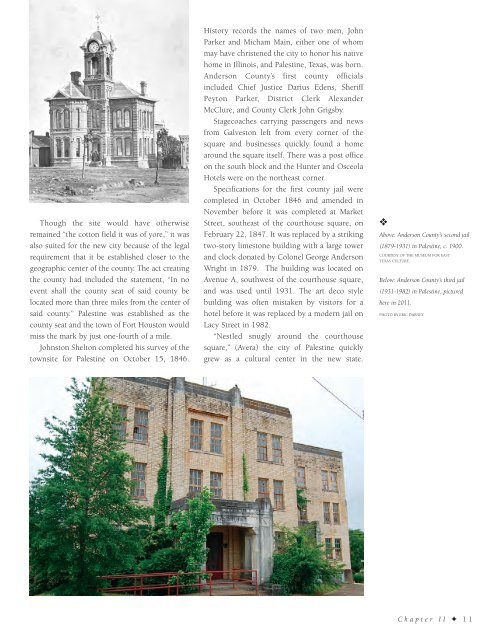Historic Palestine
An illustrated history of the Palestine, Texas area, paired with the histories of companies, families and organizations that make the region great.
An illustrated history of the Palestine, Texas area, paired with the histories of companies, families and organizations that make the region great.
You also want an ePaper? Increase the reach of your titles
YUMPU automatically turns print PDFs into web optimized ePapers that Google loves.
Though the site would have otherwise<br />
remained “the cotton field it was of yore,” it was<br />
also suited for the new city because of the legal<br />
requirement that it be established closer to the<br />
geographic center of the county. The act creating<br />
the county had included the statement, “In no<br />
event shall the county seat of said county be<br />
located more than three miles from the center of<br />
said county.” <strong>Palestine</strong> was established as the<br />
county seat and the town of Fort Houston would<br />
miss the mark by just one-fourth of a mile.<br />
Johnston Shelton completed his survey of the<br />
townsite for <strong>Palestine</strong> on October 15, 1846.<br />
History records the names of two men, John<br />
Parker and Micham Main, either one of whom<br />
may have christened the city to honor his native<br />
home in Illinois, and <strong>Palestine</strong>, Texas, was born.<br />
Anderson County’s first county officials<br />
included Chief Justice Darius Edens, Sheriff<br />
Peyton Parker, District Clerk Alexander<br />
McClure, and County Clerk John Grigsby.<br />
Stagecoaches carrying passengers and news<br />
from Galveston left from every corner of the<br />
square and businesses quickly found a home<br />
around the square itself. There was a post office<br />
on the south block and the Hunter and Osceola<br />
Hotels were on the northeast corner.<br />
Specifications for the first county jail were<br />
completed in October 1846 and amended in<br />
November before it was completed at Market<br />
Street, southeast of the courthouse square, on<br />
February 22, 1847. It was replaced by a striking<br />
two-story limestone building with a large tower<br />
and clock donated by Colonel George Anderson<br />
Wright in 1879. The building was located on<br />
Avenue A, southwest of the courthouse square,<br />
and was used until 1931. The art deco style<br />
building was often mistaken by visitors for a<br />
hotel before it was replaced by a modern jail on<br />
Lacy Street in 1982.<br />
“Nestled snugly around the courthouse<br />
square,” (Avera) the city of <strong>Palestine</strong> quickly<br />
grew as a cultural center in the new state.<br />
❖<br />
Above: Anderson County’s second jail<br />
(1879-1931) in <strong>Palestine</strong>, c. 1900.<br />
COURTESY OF THE MUSEUM FOR EAST<br />
TEXAS CULTURE.<br />
Below: Anderson County’s third jail<br />
(1931-1982) in <strong>Palestine</strong>, pictured<br />
here in 2011.<br />
PHOTO BY ERIC DABNEY.<br />
C h a p t e r I I ✦ 1 1
















